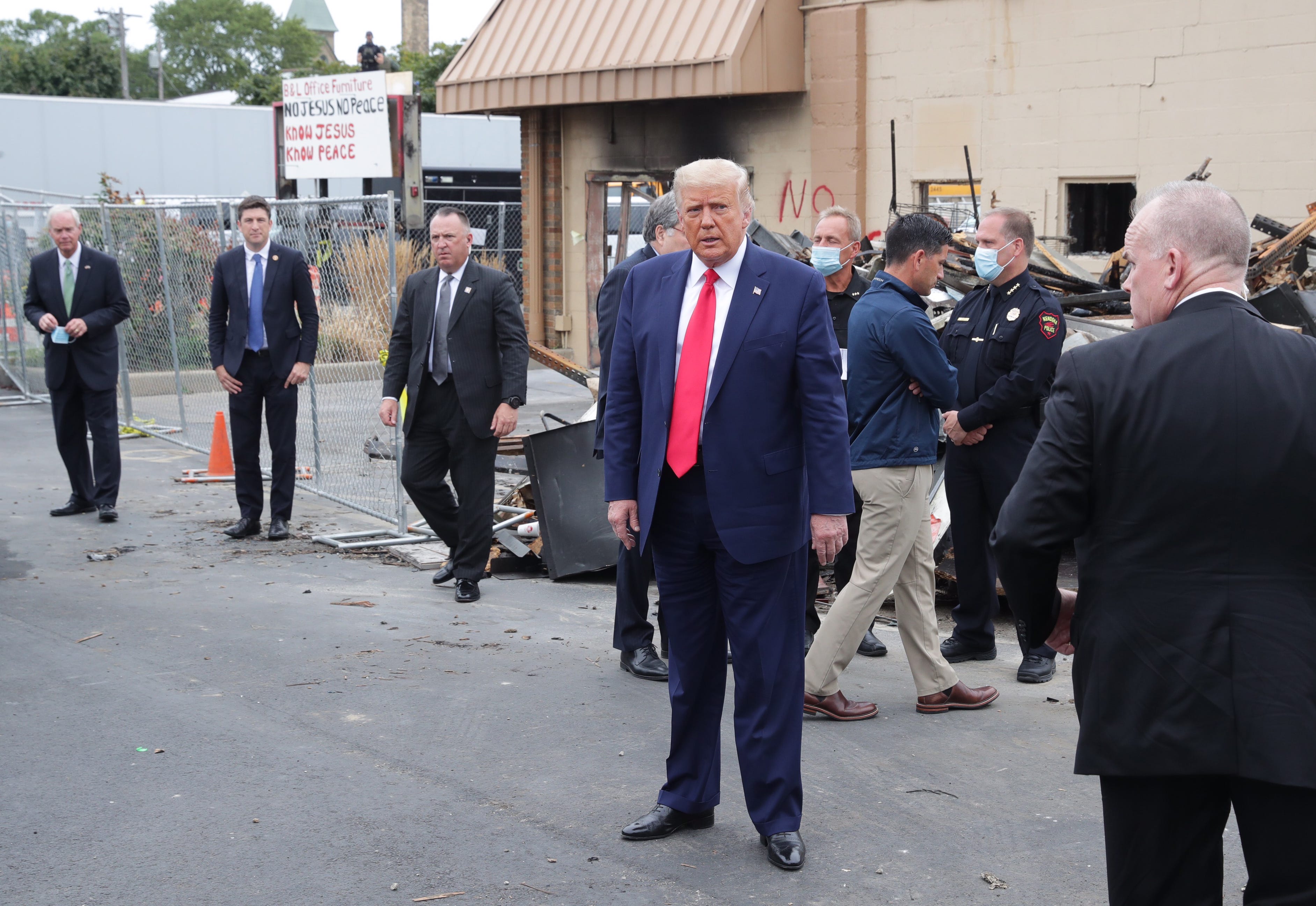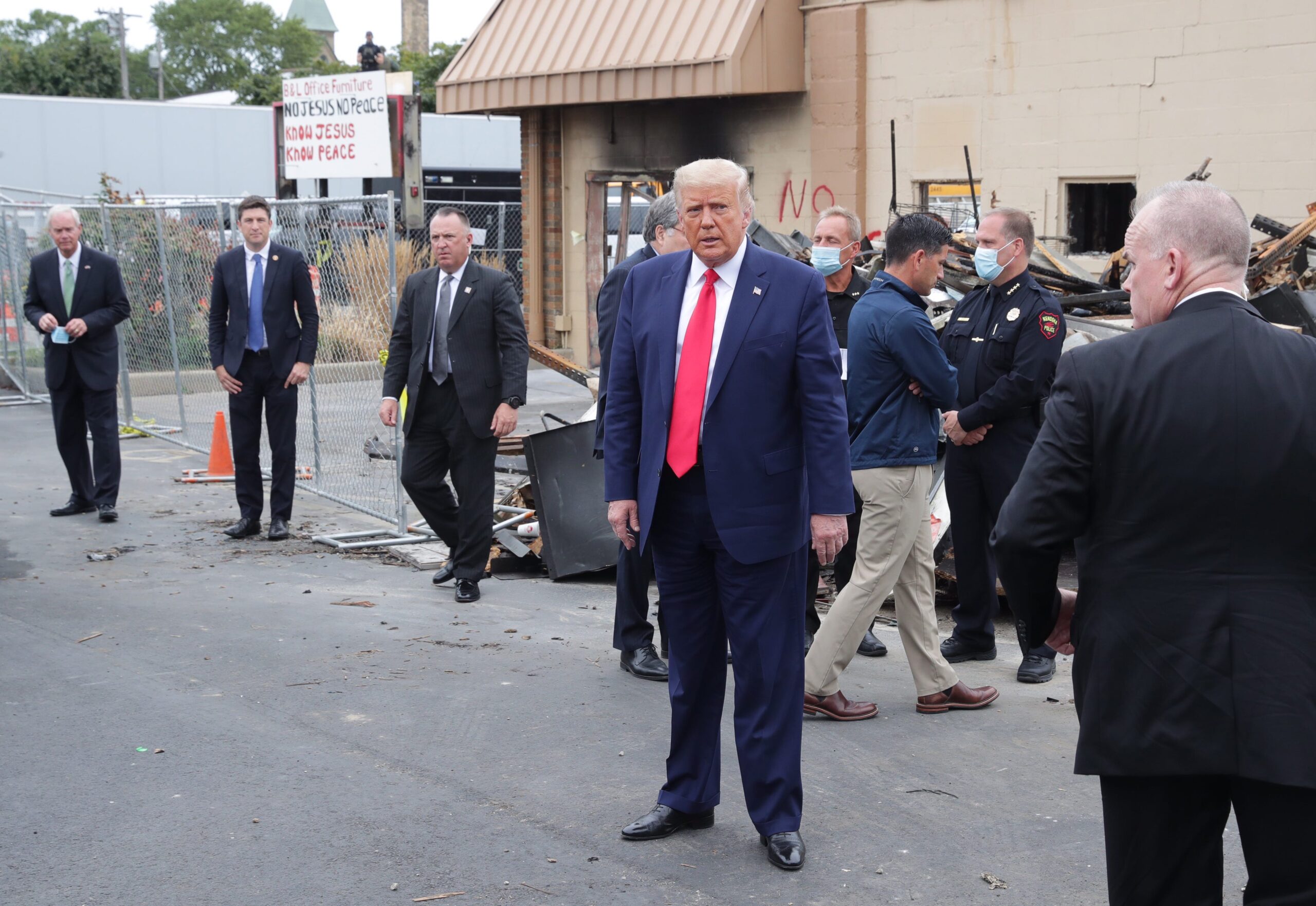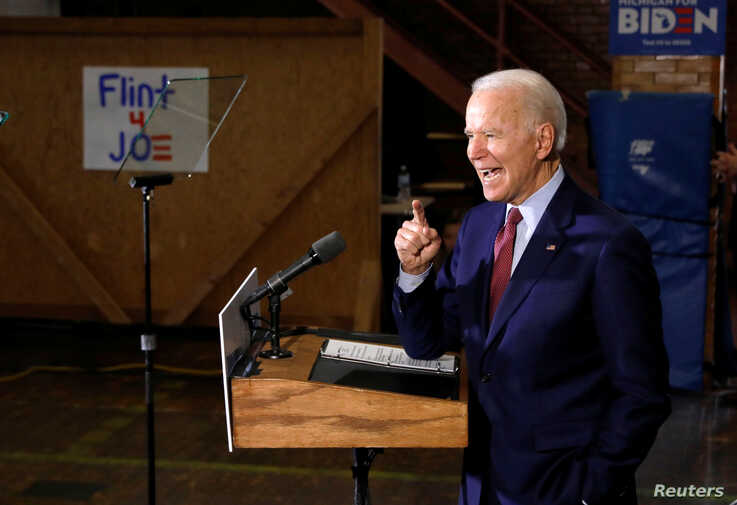Wisconsin is Trump country, demographically speaking.
In no other top battleground do rural and blue-collar white voters play as big a role — and Donald Trump won them four years ago by margins not seen here in decades.
The president’s path to victory in Wisconsin begins with trying to replicate that feat this November.
“I think that’s probably (Trump’s) biggest challenge,” said political scientist Katherine Cramer, who wrote an influential book about the shifting rural vote in Wisconsin called “The Politics of Resentment.”
“Hillary Clinton was so unpopular with these voters … They just could not stand her,” said Cramer, a professor at the University of Wisconsin-Madison. “(Joe) Biden is not as unpopular.”
2016 margin
Polling average at this stage in 2016
In 2016, Wisconsin was the “tipping point state,” the one that mathematically put Trump over the top in the Electoral College. The current presidential ad wars are testament to how vital this state is for both sides: between April and the end of September, the 13 TV markets that saw the most presidential ads included three in Wisconsin: Green Bay, La Crosse and Milwaukee.
“Wisconsin is a strange state. It just goes back and forth … It’s going to be a close one no matter how you look at it,” said Carol Zess, a longtime resident of East Troy in southern Wisconsin.
Current status
While Biden has consistently led in polling in Wisconsin, his campaign faces questions, too. Will he get the turnout he needs from Milwaukee, the state’s biggest city? Will young voters, a key part of the Democratic coalition, turn out for him?
Average polling according to Real Clear Politics
Several weeks ago, a national debate over police shootings of Black people, the protests that resulted and the bitter campaign for the presidency all converged in a small blue-collar city on Lake Michigan that drew back-to-back visits from Trump and Biden. The turmoil in Kenosha after the shooting of Jacob Blake joined a list of other incidents that have rippled through the country and the campaigns.

This fall, surging caseloads made Wisconsin the nation’s Covid-19 hotspot, putting it at the center of both the campaign and the pandemic.
Trump won Wisconsin in 2016 by 22,748 votes — the third time in the past five presidential contests this state was decided by less than a percentage point. Key to his victory was winning “non-college whites” (those without a four-year degree) by close to 20 points over Clinton, according to some post-election estimates. This group represents more than half of the state’s electorate.

But against Biden, Trump has been leading among this voting bloc by only about 10 points in Wisconsin, based on multiple surveys by different public pollsters.
Whoever wins, the political divide between cities and rural areas that widened four years ago is likely to grow even bigger this time, with a politically diverse collection of suburbs in Wisconsin potentially tipping the balance.
“That kind of polarized, urban-rural gap, based on education, occupation, living style, is even going to be more striking this time,” said political scientist James Simmons of the University of Wisconsin-Oshkosh.

Few states turn out to vote at higher rates than this one. Turnout is expected to easily outstrip 2016. But the effect of the COVID-19 pandemic on voting is a wild card, as a rising coronavirus caseload is occurring in the deeply polarized and evenly divided state where the Democratic governor has extended a mask order over the fierce objections of GOP lawmakers.
Here are four keys to the political map in Wisconsin:
Western Wisconsin
The Third Congressional District that hugs the upper Mississippi River is its own one-of-a-kind political landscape. It’s 50/50 in its partisan makeup, which is true of very few House seats these days. And while it’s full of rural white voters — a Republican group in most other places — the district has a progressive streak and a long history of voting for the Democratic presidential candidate.
If there’s one thing to know about this swingy region, known for geological reasons as the “Driftless Area” because it was never flattened by glaciers, it’s this: more than half its cities, towns and villages voted for both Barack Obama in 2012 and Trump in 2016.
The district’s 228 Obama-Trump communities are a key window into Wisconsin because four years ago they saw some of the biggest electoral shifts in the country.

Two years later, in the 2018 midterms, some Obama-Trump communities continued to trend Republican, while others swung back toward the Democrats — as did the region as a whole.
“I think the election is still very much in play” here, said Dale Schultz, a onetime GOP state lawmaker and congressional candidate from the region who does not support Trump.
“A lot of people who have come on board and are fired up for Donald Trump were people in the past who didn’t vote (but) they did come out and vote for him last time. The question is — who is he losing in order to get that base out to vote? My guess is it is largely suburbanites,” said Schultz, who notes that the northern tip of this district includes outer suburbs of Minnesota’s Twin Cities where Republicans have lost ground recently.
Dairy farms “have suffered tremendously in recent years,” Schultz notes. While that could cost Trump some votes, farm families remain a Republican group.
Western Wisconsin typically sees the biggest election swings, said Democratic pollster Paul Maslin.
Just 19 counties in the U.S. have voted for every winning president since 1980, and two of them are in this district.
If the region’s mostly rural river counties swing back at all in 2020 and Biden turns out the vote in Democratic cities such as La Crosse and Eau Claire, he has a chance to turn this area blue again. In the 2018 midterms, the district voted narrowly Democratic for governor.
2012: Obama won the district by 11 points and almost 40,000 votes.
2016: Trump won the district by 4 points and over 16,000 votes
2012-16 shift toward Republicans: 15 points and almost 56,000 votes.
Green Bay Media Market
This is one of the great “Ground Zero” hot spots in presidential politics. The 16-county Green Bay TV market saw more presidential ads between April and October than any place in the country other than Phoenix and Tampa.
This Republican-leaning region includes some red rural counties but is anchored in the more populous, purple and industrial Fox Valley that stretches from Green Bay south to Appleton and Oshkosh on Lake Winnebago. It is home to about one in five Wisconsin voters, and has some of the highest coronavirus caseloads per capita in the country.

Democrats have lost ground here over the past decade, not just in small towns but in growing suburbs. In a manufacturing-rich area, the decline of unions has played a role in that. Next to western Wisconsin, though, this may be the swingiest part of the state.
Trump won the Green Bay media market by a remarkable 18 points in 2016, but his lead here has been about half that in 2020 polling.
“Everybody is always hyper-focused on the Milwaukee suburbs,” said Mark Graul, a Green Bay consultant who ran George W. Bush’s re-election race in Wisconsin in 2004. “But the most interesting thing to me about this election is how Trump does in the suburbs of Green Bay and Appleton and those areas. Does Trump stay as strong as he was in ’16? Or does he slide there, like we saw in 2016 down in the Milwaukee suburbs?”
2012: Mitt Romney won the Green Bay media market by 4 points and roughly 22,000 votes.
2016: Trump won it by almost 18 points and about 100,000 votes.
2012-16 shift toward Republicans: 14 points and almost 80,000 votes.
City of Milwaukee
One predictable outcome in Wisconsin elections: Democratic landslides in the city of Milwaukee.
But what’s unpredictable: Democratic turnout in the city of Milwaukee, which generates close to 10% of the statewide vote.
Sagging Milwaukee turnout contributed to Clinton’s defeat in 2016. She got almost 39,000 fewer votes in Milwaukee than Obama did in 2012. Overall turnout in the city was down 14%, and the decline was far bigger in majority-Black wards.
Compare this to Wisconsin’s other big blue bastion: the ultra-politicized capital city of Madison and the blue and growing Dane County suburbs that surround it, which routinely generate ever larger Democratic landslides.
Milwaukee is a much bigger wildcard, especially with questions about whether Biden will match Clinton’s numbers among voters of color.
Milwaukee Congresswoman Gwen Moore once said the get-out-the-vote effort in the city four years ago was like “watching the tumbleweeds roll down the street.”
“Four years ago, I was begging for money, begging for help, begging people not to take Milwaukee for granted,” Moore said in a recent interview.
While some think vice-presidential candidate Kamala Harris could help boost turnout in a city that is roughly 40% Black and almost 20% Hispanic, Moore said it’s about the ground game. The city and local Democrats suffered a setback when the national convention it hosted went almost entirely virtual.
But, Moore said, “We’re going to have a (different) level of organization and technology and deployment and effort” this time compared to 2016.

Milwaukee has historically been a huge part of the Democratic Party’s early vote operation. In the pandemic, city election officials expect 60% to 70% of Milwaukee voters to cast their ballots without going to the polls on election day — a higher number than expected statewide.
After mustering only five polling places in the state’s April election as the coronavirus crisis mounted, the city plans more than 170 this time.

2012: Obama won the city by 60 points and more than 170,000 votes.
2016: Clinton won the city by 58 points and roughly 143,000 votes.
2012-16: Swing away from the Democrats: 2 points and roughly 27,000 votes.
Milwaukee’s Republican suburbs
Known collectively as the “WOW counties,” the deep red suburbs outside Milwaukee are the traditional bedrock of the Republican Party in Wisconsin.
Few places in America turn out at higher rates than Waukesha, Ozaukee and Washington counties, whose communities have among the highest incomes and rates of college education in the state. And few suburban counties outside large northern cities are as Republican as these.
But as red as they are, these overwhelmingly white counties aren’t generating GOP landslides as big as they used to. Trump was deeply unpopular among Republican voters here in the 2016 Wisconsin presidential primary, losing badly to Ted Cruz.
“Many of them didn’t see Trump as a real Republican,” said Lilly Goren, a political scientist at Carroll College in Waukesha County.
Trump later won the WOW counties by a combined 28 points against Clinton, but that was smaller than Romney’s margin against Obama and far smaller than the margins GOP Gov. Scott Walker piled up in these counties in his three election victories. Trump ran well behind GOP Sen. Ron Johnson on the same 2016 ballot, but many Republicans think Johnson helped Trump in these red counties by boosting turnout.
As Goren notes, Johnson won’t be on the ballot this time.
But Trump is also far more popular with Republican voters as president than he was during the 2016 campaign. The president’s complicated history with these voters makes the area a challenge, but also an opportunity if he can perform as well as Republicans have in the past.
“We Republicans, particularly in the WOW counties … need to do two things. One is to find out which Republicans didn’t vote in ‘16 for one reason or the other and turn them out,” said Jim Sensenbrenner, the 42-year GOP congressman who represents a good part of this area and is retiring after this term. “Second is we’ve got to do a good persuasion job for people who might have soured on Trump for one reason or another and be able to make the contrast (with Biden).”

Sensenbrenner cited two factors that could help max out the Republican vote: the fallout from the turmoil in Kenosha, giving fuel to Trump’s “law and order” message, and the coming fight over the Supreme Court vacancy created by the death of Justice Ruth Bader Ginsburg.
Maslin, the Democratic pollster, said there’s a good chance the Supreme Court fight will be a wash politically in the state, where the race has been stable for months.
“Each side’s base gets inflamed, and it probably cancels each other out,” he said.
Polling this year shows Trump leading Biden in these counties by roughly the same margin by which he defeated Clinton four year earlier — close to 30 points.
2012: Romney won the WOW counties by 35 points and more than 132,000 votes.
2016: Trump won the WOW counties by 28 points and more than 104,000 votes.
2012-16 shift away from Republicans: 7 points and 28,000 votes.
Wisconsin facts
Six states above all others have emerged as the top electoral prizes in the 2020 race for president: Wisconsin, Michigan, Pennsylvania, Arizona, Florida and North Carolina.
They represent 101 of the 270 electoral votes needed to win the White House. These aren’t the only battlegrounds in 2020, but their size and competitiveness has made them the states most likely to decide the presidency.
In this series, the USA TODAY Network offers a closer look at the battlegrounds within the battlegrounds – the keys to the political map in the states that are likely to choose the next president.


